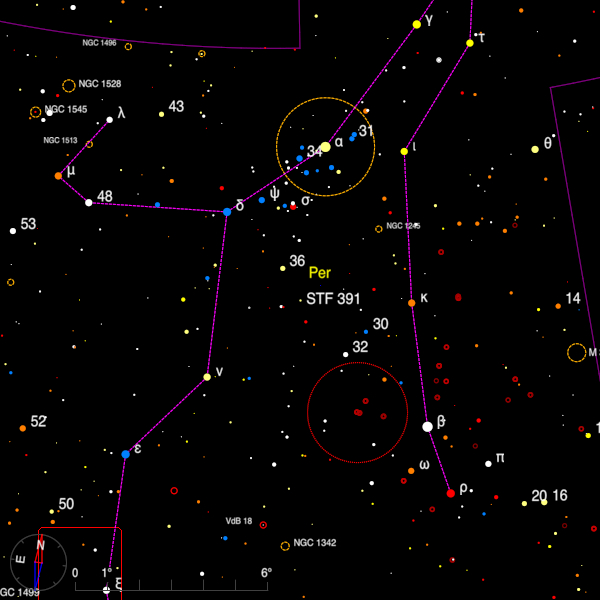December 2020 - Double Star of the Month
About 5 degrees due south of alpha Persei (Mirfak) is the rather faint pair STF 391 (03 29 13.74 +45 02 57.5). The Washington Double Star (WDS) catalogue gives the magnitudes as 7.6 and 8.3 and the stars are currently 3".9, a value that has remained unchanged for 200 years or so.

The primary is a B1 dwarf and its companion a giant star of spectral type G8. The colours of the stars might therefore be expected to be white and yellow. Sissy Haas in her book 'Double stars for small telescopes' gives the colours as white and red, as observed in her 60-mm refractor. On the other hand, when I observed them with a 21-cm reflector some years ago, I noted that there was a superb contrast of yellow and blue. I have not yet observed the stars in the Cambridge 8-inch refractor but will try to do so at an early opportunity.
The Gaia satellite provides a distance of about 3,100 light-years for each component with an error of about 150 light-years in each case. Whilst in the area check out S 430 (03 38 18.53 +44 48 06.5), approximately 2 degrees east and slightly south, a fine pair - 7.2, 7.5, 96 degrees, 41".
In the far south-eastern and rather sparse corner of Hydrus near the border with Octans is HJ 3568 (03 07 32.13 -78 59 21.3). This is one of John Herschel's Cape discoveries. The primary is a naked-eye star (+5.7) whilst some 15" distant is a magnitude 7.7 companion. In addition, A is also a spectroscopic binary and a delta Scuti variable, known as BN Hyi.

The stars are equally distant (263 light-years) according to Gaia DR2 and both are moving through space in the same direction and at similar velocity but there has been little change in the relative motion of the stars since the 1830s giving no clue as to the orbital period. Ernst Hartung notes that this is a fine, unequal pair yellow and bluish-white
.
Bob Argyle - Double Star Section Director